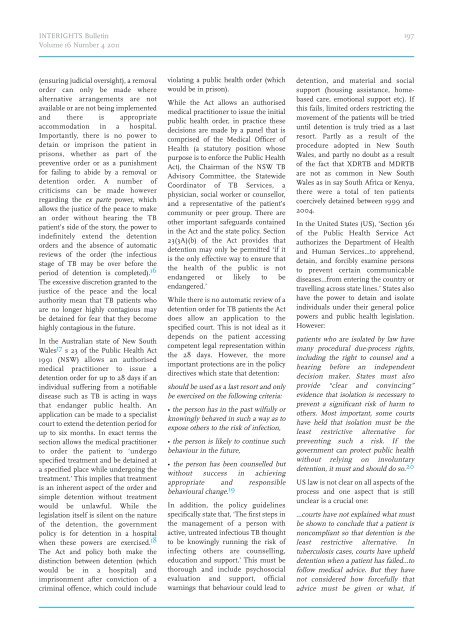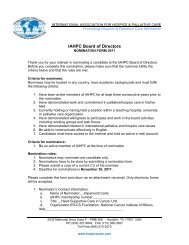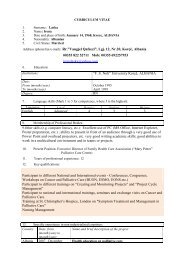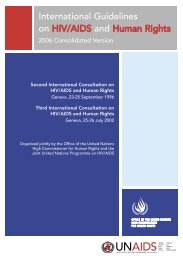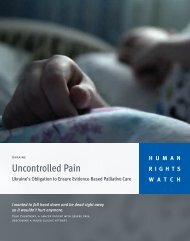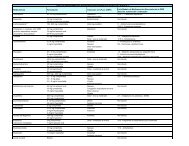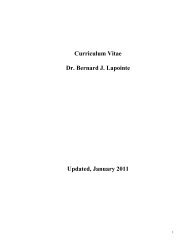INTERIGHTS Bulletin
INTERIGHTS Bulletin
INTERIGHTS Bulletin
Create successful ePaper yourself
Turn your PDF publications into a flip-book with our unique Google optimized e-Paper software.
<strong>INTERIGHTS</strong> <strong>Bulletin</strong><br />
Volume 16 Number 4 2011<br />
197<br />
(ensuring judicial oversight), a removal<br />
order can only be made where<br />
alternative arrangements are not<br />
available or are not being implemented<br />
and there is appropriate<br />
accommodation in a hospital.<br />
Importantly, there is no power to<br />
detain or imprison the patient in<br />
prisons, whether as part of the<br />
preventive order or as a punishment<br />
for failing to abide by a removal or<br />
detention order. A number of<br />
criticisms can be made however<br />
regarding the ex parte power, which<br />
allows the justice of the peace to make<br />
an order without hearing the TB<br />
patient’s side of the story, the power to<br />
indefinitely extend the detention<br />
orders and the absence of automatic<br />
reviews of the order (the infectious<br />
stage of TB may be over before the<br />
period of detention is completed). 16<br />
The excessive discretion granted to the<br />
justice of the peace and the local<br />
authority mean that TB patients who<br />
are no longer highly contagious may<br />
be detained for fear that they become<br />
highly contagious in the future.<br />
In the Australian state of New South<br />
Wales 17 s 23 of the Public Health Act<br />
1991 (NSW) allows an authorised<br />
medical practitioner to issue a<br />
detention order for up to 28 days if an<br />
individual suffering from a notifiable<br />
disease such as TB is acting in ways<br />
that endanger public health. An<br />
application can be made to a specialist<br />
court to extend the detention period for<br />
up to six months. In exact terms the<br />
section allows the medical practitioner<br />
to order the patient to ‘undergo<br />
specified treatment and be detained at<br />
a specified place while undergoing the<br />
treatment.’ This implies that treatment<br />
is an inherent aspect of the order and<br />
simple detention without treatment<br />
would be unlawful. While the<br />
legislation itself is silent on the nature<br />
of the detention, the government<br />
policy is for detention in a hospital<br />
when these powers are exercised. 18<br />
The Act and policy both make the<br />
distinction between detention (which<br />
would be in a hospital) and<br />
imprisonment after conviction of a<br />
criminal offence, which could include<br />
violating a public health order (which<br />
would be in prison).<br />
While the Act allows an authorised<br />
medical practitioner to issue the initial<br />
public health order, in practice these<br />
decisions are made by a panel that is<br />
comprised of the Medical Officer of<br />
Health (a statutory position whose<br />
purpose is to enforce the Public Health<br />
Act), the Chairman of the NSW TB<br />
Advisory Committee, the Statewide<br />
Coordinator of TB Services, a<br />
physician, social worker or counsellor,<br />
and a representative of the patient’s<br />
community or peer group. There are<br />
other important safeguards contained<br />
in the Act and the state policy. Section<br />
23(3A)(b) of the Act provides that<br />
detention may only be permitted ‘if it<br />
is the only effective way to ensure that<br />
the health of the public is not<br />
endangered or likely to be<br />
endangered.’<br />
While there is no automatic review of a<br />
detention order for TB patients the Act<br />
does allow an application to the<br />
specified court. This is not ideal as it<br />
depends on the patient accessing<br />
competent legal representation within<br />
the 28 days. However, the more<br />
important protections are in the policy<br />
directives which state that detention:<br />
should be used as a last resort and only<br />
be exercised on the following criteria:<br />
• the person has in the past wilfully or<br />
knowingly behaved in such a way as to<br />
expose others to the risk of infection,<br />
• the person is likely to continue such<br />
behaviour in the future,<br />
• the person has been counselled but<br />
without success in achieving<br />
appropriate and responsible<br />
behavioural change. 19<br />
In addition, the policy guidelines<br />
specifically state that, ‘The first steps in<br />
the management of a person with<br />
active, untreated infectious TB thought<br />
to be knowingly running the risk of<br />
infecting others are counselling,<br />
education and support.’ This must be<br />
thorough and include psychosocial<br />
evaluation and support, official<br />
warnings that behaviour could lead to<br />
detention, and material and social<br />
support (housing assistance, homebased<br />
care, emotional support etc). If<br />
this fails, limited orders restricting the<br />
movement of the patients will be tried<br />
until detention is truly tried as a last<br />
resort. Partly as a result of the<br />
procedure adopted in New South<br />
Wales, and partly no doubt as a result<br />
of the fact that XDRTB and MDRTB<br />
are not as common in New South<br />
Wales as in say South Africa or Kenya,<br />
there were a total of ten patients<br />
coercively detained between 1999 and<br />
2004.<br />
In the United States (US), ‘Section 361<br />
of the Public Health Service Act<br />
authorizes the Department of Health<br />
and Human Services…to apprehend,<br />
detain, and forcibly examine persons<br />
to prevent certain communicable<br />
diseases…from entering the country or<br />
travelling across state lines.’ States also<br />
have the power to detain and isolate<br />
individuals under their general police<br />
powers and public health legislation.<br />
However:<br />
patients who are isolated by law have<br />
many procedural due-process rights,<br />
including the right to counsel and a<br />
hearing before an independent<br />
decision maker. States must also<br />
provide “clear and convincing”<br />
evidence that isolation is necessary to<br />
prevent a significant risk of harm to<br />
others. Most important, some courts<br />
have held that isolation must be the<br />
least restrictive alternative for<br />
preventing such a risk. If the<br />
government can protect public health<br />
without relying on involuntary<br />
detention, it must and should do so. 20<br />
US law is not clear on all aspects of the<br />
process and one aspect that is still<br />
unclear is a crucial one:<br />
…courts have not explained what must<br />
be shown to conclude that a patient is<br />
noncompliant so that detention is the<br />
least restrictive alternative. In<br />
tuberculosis cases, courts have upheld<br />
detention when a patient has failed…to<br />
follow medical advice. But they have<br />
not considered how forcefully that<br />
advice must be given or what, if


